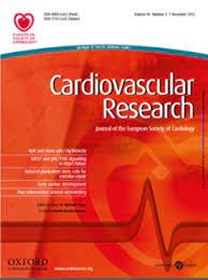Enhanced intracranial aneurysm development in a rat model of polycystic kidney disease
IF 10.2
1区 医学
Q1 CARDIAC & CARDIOVASCULAR SYSTEMS
引用次数: 0
Abstract
Aim Polycystic kidney disease (PKD) patients have a high intracranial aneurysms (IAs) incidence and risk of rupture. The mechanisms that make PKD patients more vulnerable to IA disease are still not completely understood. The PCK rat is a well-known PKD model and has been extensively used to study cyst development and kidney damage. Here, we used this rat model to study IA induction and vulnerability. Methods and results IAs were induced in wild-type (WT) and PCK rats and their incidence was followed. Variation in the anatomy of the circle of Willis was studied in PCK rats and PKD patients. Immunohistochemistry was performed in rat IAs and in human ruptured and unruptured IAs from patients enrolled in the @neurIST observational cohort. An increased frequency of fatal aortic dissection was unexpectedly observed in PCK rats, which was due to modifications in the elastic architecture of the aorta in combination with the induced hypertension. Interestingly, IAs developed faster in PCK rats compared to WT rats. Variations in the anatomy of the circle of Willis were identified in PCK rats and PKD patients, a risk factor that may (in part) explain the higher IA incidence found in these groups. At 2-weeks after induction, the endothelium of IAs from PCK rats showed a decrease in the tight junction proteins zonula occludens-1 and claudin-5. Furthermore, the type III collagen content was lower in IAs of PCK rats at 4-weeks post-surgery. The decrease in tight junction proteins was also observed in the endothelium of human ruptured IAs compared to unruptured IAs. Conclusions Our study showed that PCK rats are more sensitive to IA induction. Variations in the anatomy of the circle of Willis and impaired regulation of tight junction proteins might put PCK rats and PKD patients more at risk of developing vulnerable IAs.多囊肾病大鼠模型颅内动脉瘤发展增强
目的多囊肾病(PKD)患者颅内动脉瘤(IAs)的发生率和破裂风险较高。使PKD患者更容易患IA疾病的机制仍未完全了解。PCK大鼠是一种众所周知的PKD模型,已被广泛用于研究囊肿发展和肾脏损害。在此,我们利用该大鼠模型研究IA诱导和易感性。方法与结果采用野生型(WT)大鼠和PCK大鼠诱导IAs,并观察其发生情况。研究了PCK大鼠和PKD患者威利斯环解剖结构的变化。在@neurIST观察队列中,对大鼠IAs和人破裂和未破裂IAs进行免疫组化。在PCK大鼠中意外地观察到致命性主动脉夹层的频率增加,这是由于主动脉弹性结构的改变和诱导的高血压。有趣的是,与WT大鼠相比,PCK大鼠的IAs发展更快。在PCK大鼠和PKD患者中发现了威利斯环解剖结构的变化,这一危险因素可能(部分)解释了在这些组中发现的较高的IA发生率。诱导后2周,PCK大鼠IAs内皮中紧密连接蛋白occludenzonula -1和claudin-5表达减少。此外,术后4周PCK大鼠IAs中III型胶原含量较低。与未破裂的血管内皮细胞相比,血管内皮细胞中紧密连接蛋白的表达也有所减少。结论PCK大鼠对IA诱导更为敏感。Willis环解剖结构的变化和紧密连接蛋白的调节受损可能使PCK大鼠和PKD患者更容易发生易感IAs。
本文章由计算机程序翻译,如有差异,请以英文原文为准。
求助全文
约1分钟内获得全文
求助全文
来源期刊

Cardiovascular Research
医学-心血管系统
CiteScore
21.50
自引率
3.70%
发文量
547
审稿时长
1 months
期刊介绍:
Cardiovascular Research
Journal Overview:
International journal of the European Society of Cardiology
Focuses on basic and translational research in cardiology and cardiovascular biology
Aims to enhance insight into cardiovascular disease mechanisms and innovation prospects
Submission Criteria:
Welcomes papers covering molecular, sub-cellular, cellular, organ, and organism levels
Accepts clinical proof-of-concept and translational studies
Manuscripts expected to provide significant contribution to cardiovascular biology and diseases
 求助内容:
求助内容: 应助结果提醒方式:
应助结果提醒方式:


